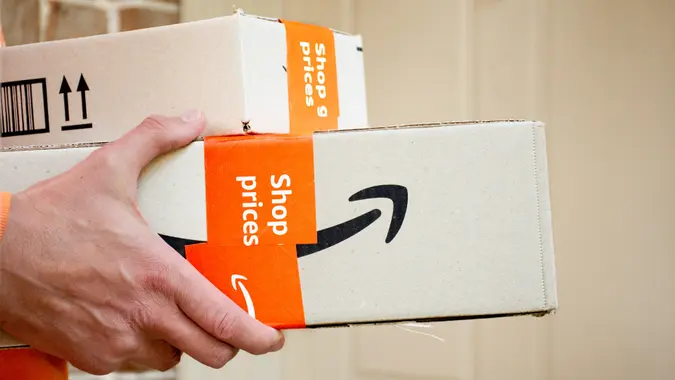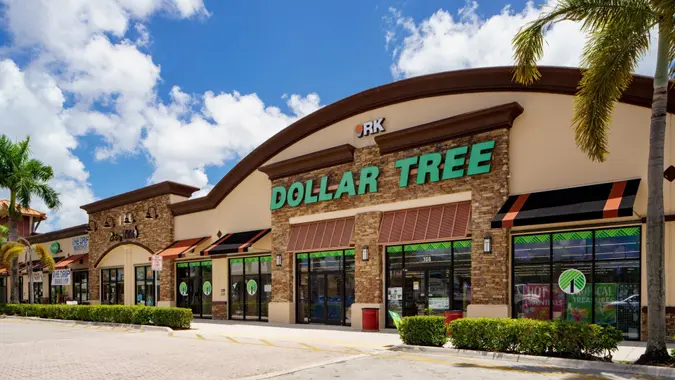Americans Who Spend Money Are Happier Than Those That Save It — Is There a Healthy Compromise?

Commitment to Our Readers
GOBankingRates' editorial team is committed to bringing you unbiased reviews and information. We use data-driven methodologies to evaluate financial products and services - our reviews and ratings are not influenced by advertisers. You can read more about our editorial guidelines and our products and services review methodology.

20 Years
Helping You Live Richer

Reviewed
by Experts

Trusted by
Millions of Readers
Anyone who’s engaged in retail therapy at Target, reveled in the discount finds of Aldi’s “Aisle of Shame,” or experienced a weekend shopping trip in a big city knows this intuitively: Spending money can make you happy.
That’s not surprising, as scientific studies have shown that dopamine, our body’s feel-good hormone, is released not just the moment we make a purchase, but also in the time leading up to that purchase — in anticipation of your reward.
A new study commissioned by Citizens Pay, conducted by OnePoll and reported by Talker, revealed some surprising findings, however.
People who consider themselves “spenders,” rather than “savers,” aren’t just happier while shopping. They tend to be happier in life, overall.
Spenders, who made up 56% of the 2,000 Americans polled, said they were happier in their relationships, work life, personal life — and even in their financial lives.
| Spenders | Savers | |
| Happier in Relationships | 78% | 63% |
| Happier in Work Life | 78% | 57% |
| Happier in Personal Life | 77% | 71% |
| Happier with their Finances | 73% | 56% |
The greatest difference came in their work lives, perhaps because spenders enjoy the fruits of their labor immediately through their purchases. This might make their work seem more fulfilling, since they reap the rewards more frequently.
“Research suggests there’s actually a lot of psychological and therapeutic value when you’re shopping — if done in moderation, of course,” said clinical psychologist Scott Bea, PsyD., in an article published by the Cleveland Clinic.
What Makes a “Spender” vs. a “Saver?”
In the study, spenders defined themselves as someone who would splurge for something they really want, while savers said they don’t shop until something goes on sale or becomes a necessity. Ten percent of those polled didn’t identify as either type of shopper.
Savers, which made up 34% of the people polled, are ahead of spenders in one area. Savers spend just $348 on non-essential items in any given week as compared to spenders, who drop $621 on things they may not need.
Likewise, only 29% of savers’ annual income goes toward miscellaneous purchases, compared to 38% for spenders.
Finding a Balance Between Spending and Saving
While purchasing the things you want rather than bargain hunting or waiting for a deal might make you happier, it’s important to make sure your spending doesn’t interfere with your overall financial goals.
If you’re a spender, think about the financial security you could build with an extra 9% of your income going toward emergency savings or retirement instead of stuff you may not need.
Additionally, if you tend to feel remorse after making a purchase, only to repeat the cycle next time, it could be a sign of shopping addiction or impulsive shopping.
“Whether you’re adding items to your shopping cart online or visiting your favorite boutique for a few hours, you do get a psychological and emotional boost,” Bea said, per Cleveland Clinic. “Even window shopping or online browsing can bring brain-fueled happiness. But again, you want to make sure it doesn’t get out of hand.”
All Sorts of Shoppers Take Large Purchases More Seriously
In spite of random purchases costing spenders hundreds more per week, spenders and savers shared one thing in common: Both groups carefully considered big purchases before pulling out their wallet for items like electronics, household appliances, cars, vacations, and fitness equipment.
The average American said they research roughly 12 hours before making any purchase greater than $1,762, and the average person waits 17 days to see if an item may go on sale.
In fact, 61% of spenders say they take time to consider the financial impact of a big purchase, compared to 59% of shoppers, overall.
And, according to Christine Roberts — president at Citizens Pay — spending responsibly is important for spenders and savers, alike. “What’s really important is the level of consideration people have and the impact their purchases have on their financial livelihood,” she told Talker.
 Written by
Written by  Edited by
Edited by 

























